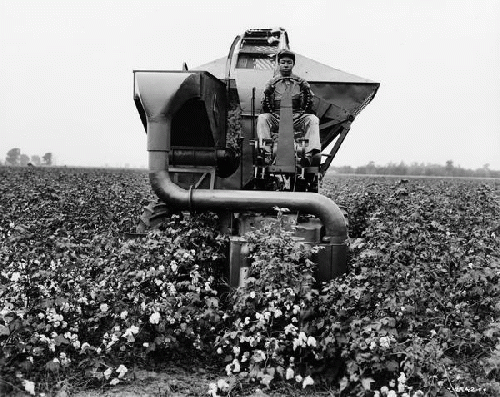| Back OpEd News | |||||||
|
Original Content at https://www.opednews.com/articles/African-Americans-Technol-by-Ali-Hangan-Innovation-160221-845.html (Note: You can view every article as one long page if you sign up as an Advocate Member, or higher). |
|||||||
February 21, 2016
African-Americans, Technology, and Migration
By Ali Hangan
Ali Hangan describes how technical innovations lead to African-American migration.
::::::::
For the better part of the 20th century, over 5 million African-Americans left the southern U.S. to find a new life in Northeastern cities and the Western states. This large shift in population has been coined the "The Great Migration."
Many of our history books explain the cause of the Great Migration as rooted to African-Americans' seeking escape from southern segregationist laws and culture known as Jim Crow. African-Americans faced discrimination all throughout the United States, but discrimination alone did not lead to a migration en masse as it did from the South. Furthermore, African-Americans had well-established communities in the South, with deeply-rooted enclaves, much like the ones established in later years in Northeastern and Western cities. So, the question must be asked: "Why did so many African-Americans leave the South?
To answer this question, we must go back to the end of the Civil War. At the end of the Civil War, the Southern economy was destroyed. Although many freed slaves left the South, millions remained because they knew no other life or had few skills outside of being a field laborer.
A new economic relationship evolved from slavery called sharecropping. Sharecropping established a new social and economic order between landowner and field laborer. The landowner let the laborers live on a parcel of land in exchange for working the crops grown on the land held by a landowner. The laborer and his family paid for their expenses (rent, food, etc.) out of their share of the yearly profits earned from the crops they harvested and sold.
In theory, the sharecropping system sounded fair, but in practice, sharecropping benefited the landowner more than the laborer. The tools, seed and any other materials for picking the crop by the laborer were purchased on credit extended by the landowner from a store that was also owned by the same landowner. Once the family sold their crops, their share of the profits disappeared by having to pay back the initial debt that was extended by the same landowner to the laborer. In many instances, the laborer never made enough money to pay off their debt. The cycle of perpetual debt kept the laborer and his family beholden to the landowner and tied to the land. Ultimately, a disruptive, technical force would bring an end to the sharecropping system.
At the end of the 19th century, the mechanical cotton picker was introduced into cotton production. It was initially pulled by a horse and could pick the same amount of cotton as 50 laborers. The mechanical cotton picker increased production and saved landowners thousands of dollars a year. (Page, Arthur W. (December 1910). "A Cotton-Harvester At Last: A Machine That Will Emancipate Cotton From Low-Grade Labor". The World's Work: A History of Our Time XXI: 13748--13760. Retrieved 2009-07-10.)

This photograph was taken during field operations on the Ohlendorf plantation near Osceola, Arkansas.
(Image by The Library of Congress) Details DMCA
In time, the invention of the combustible engine soon replaced the horse and the mechanical cotton picker became the tool of choice by cotton growers. The eschewing of the horse for the combustible engine increased productivity many times over, improving upon the level of production and eliminating the need for human labors to pick cotton. When America entered World War II, the demand for cotton increased and the use of the mechanical cotton picker grew more widespread in cotton production.
During World War II, increased demand for cotton pushed landowners to use more mechanical cotton pickers leading to the final demise of the sharecropping system. Because African-Americans no longer found work in the fields, many left for the southern industrial cities such as Atlanta, Georgia, Birmingham, Alabama, and Houston, Texas in search of work. But the draw of factory jobs in Northern cities, such as Pittsburgh, Chicago, Detroit and even westward to Los Angeles, drew more and more families into these cities, leading to the largest U.S. migration in our nation's history.
Over the past 30 years, there has been a steady stream of African-Americans returning to the South in search of better job opportunities and lower housing costs. Today, 57 percent of African-Americans live in the South; the highest percentage in a half century ("The Great Reverse Migration: African-Americans are abandoning the Northern cities that have failed them", September 30, 2012, Pittsburgh Post-Gazette).
As we have seen technological innovation lead to the African-Americans' departure from the South, in a twist of irony, it is a technological innovation that has drawn African-Americans back to their southern past. In this case, the evolution and standardization of air conditioning technology have been, by and large, the technical basis that continues to make the southern economy a more inviting place to live despite its hot and humid climate. As a result, more African-Americans continue to migrate back to the South.
While we must continue to appreciate the overcoming of the past, present and future social challenges that make up African-American history and the broader American story, ultimately, all history finds its foundation in technical innovations and the economy.
(Article changed on February 21, 2016 at 16:56)
(Article changed on February 21, 2016 at 16:58)
(Article changed on February 21, 2016 at 17:04)
(Article changed on February 21, 2016 at 22:48)
Authors Bio:
Ali Hangan is high school teacher in Pomona, California.